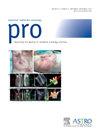在区域结节照射中排除腋窝上1级不会增加乳腺癌患者的腋窝复发风险。
IF 3.4
3区 医学
Q2 ONCOLOGY
引用次数: 0
摘要
目的:乳腺癌术后放疗中区域结节照射(RNI)的最佳范围,尤其是腋窝1级(AXL1),仍不确定。本研究旨在比较乳腺癌患者接受包括整个腋窝在内的广泛RNI和不包括AXL1上部的有限RNI的临床疗效:一项回顾性分析纳入了 1780 名患有非转移性单侧乳腺癌的女性患者,她们在 2007 年至 2018 年期间接受了术后放疗期间的 RNI。根据放射野中上部AXL1的纳入情况,将患者分为广泛RNI组和有限RNI组。倾向评分匹配得出了1020名患者的队列。以5年腋窝复发率≤2%为界,评估了局限性RNI与广泛性RNI相比的非劣效性:中位随访 67.9 个月后,广泛 RNI 组和有限 RNI 组的 5 年腋窝复发率相似(1.2% 对 1.6%;Plog-rank=0.790)。有限RNI显示出非劣性,差异为0.4%(95%置信区间,-1.1%-1.9%;Pnon-inferiority=0.019)。广泛RNI组和有限RNI组的5年无病生存率(87.9% vs. 91.5%;Plog-rank=0.122)和总生存率(94.1% vs. 96.9%;Plog-rank=0.260)无显著差异。多变量分析显示,淋巴管侵犯(危险比[HR],5.17;P=0.02)和激素受体阴性状态(HR,11.73;P=0.002)与腋窝复发风险较高有关,而局限性RNI与此无显著关联(HR,1.35;P=0.652)。亚组分析显示,对于淋巴管侵犯、激素受体阴性、淋巴结转移阳性或切除结节数量较少的患者,广泛RNI并不能改善腋窝控制:结论:在乳腺癌患者中,将上AXL1从放射野中排除的有限RNI显示出与广泛RNI相当的腋窝复发率。研究表明,广泛RNI可能不会带来额外的治疗效果,而有限RNI似乎是区域控制的有效选择。本文章由计算机程序翻译,如有差异,请以英文原文为准。
Excluding Upper Axillary Level 1 in Regional Nodal Irradiation Does Not Increase Axillary Recurrence Risk in Patients With Breast Cancer
Purpose
The optimal extent of regional nodal irradiation (RNI) in postoperative radiation therapy for breast cancer, particularly regarding axillary level 1 (AXL1), remains uncertain. This study aimed to compare clinical outcomes between extensive RNI including the entire axilla and limited RNI excluding the upper AXL1 in patients with breast cancer.
Methods and Materials
A retrospective analysis included 1780 women with nonmetastatic unilateral breast cancer who underwent RNI during postoperative radiation therapy between 2007 and 2018. Patients were classified into extensive and limited RNI groups based on the upper AXL1 inclusion in the radiation field. Propensity-score matching yielded a cohort of 1020 patients. Noninferiority of limited RNI compared with extensive RNI was assessed with a defined margin of ≤2% in the 5-year axillary recurrence rate.
Results
After a median follow-up of 67.9 months, the 5-year axillary recurrence rates were similar between extensive and limited RNI groups (1.2% vs 1.6%; Plog-rank= .790). Limited RNI demonstrated noninferiority with a 0.4% difference (95% confidence interval, –1.1% to 1.9%; Pnoninferiority= .019). Disease-free survival (87.9% vs 91.5%; Plog-rank= .122) and overall survival (94.1% vs 96.9%; Plog-rank= .260) at 5 years were not significantly different between extensive and limited RNI groups. Multivariable analysis revealed that lymphovascular invasion (hazard ratio [HR], 5.17; P = .02) and negative hormone receptor status (HR, 11.73; P = .002) were associated with a higher risk of axillary recurrence, whereas limited RNI showed no significant association (HR, 1.35; P = .652). Subgroup analysis demonstrated that extensive RNI did not improve axillary control in patients with lymphovascular invasion, hormone receptor negativity, positive lymph node metastasis, or a small number of nodes removed.
Conclusions
Limited RNI, excluding the upper AXL1 from the radiation field, demonstrated axillary recurrence rates comparable with those of extensive RNI in patients with breast cancer. The study suggests that extensive RNI may not provide additional therapeutic benefits, whereas limited RNI appears to be a valid option for regional control.
求助全文
通过发布文献求助,成功后即可免费获取论文全文。
去求助
来源期刊

Practical Radiation Oncology
Medicine-Radiology, Nuclear Medicine and Imaging
CiteScore
5.20
自引率
6.10%
发文量
177
审稿时长
34 days
期刊介绍:
The overarching mission of Practical Radiation Oncology is to improve the quality of radiation oncology practice. PRO''s purpose is to document the state of current practice, providing background for those in training and continuing education for practitioners, through discussion and illustration of new techniques, evaluation of current practices, and publication of case reports. PRO strives to provide its readers content that emphasizes knowledge "with a purpose." The content of PRO includes:
Original articles focusing on patient safety, quality measurement, or quality improvement initiatives
Original articles focusing on imaging, contouring, target delineation, simulation, treatment planning, immobilization, organ motion, and other practical issues
ASTRO guidelines, position papers, and consensus statements
Essays that highlight enriching personal experiences in caring for cancer patients and their families.
 求助内容:
求助内容: 应助结果提醒方式:
应助结果提醒方式:


